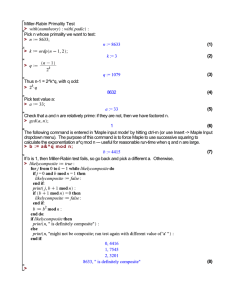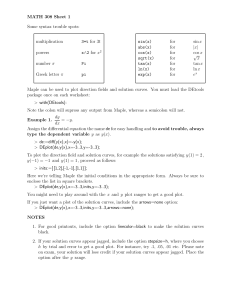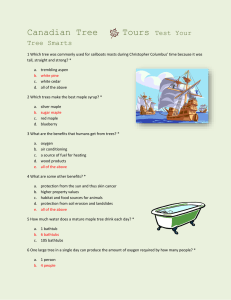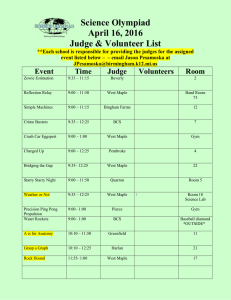Jose Lopez, Tom Ryan
advertisement
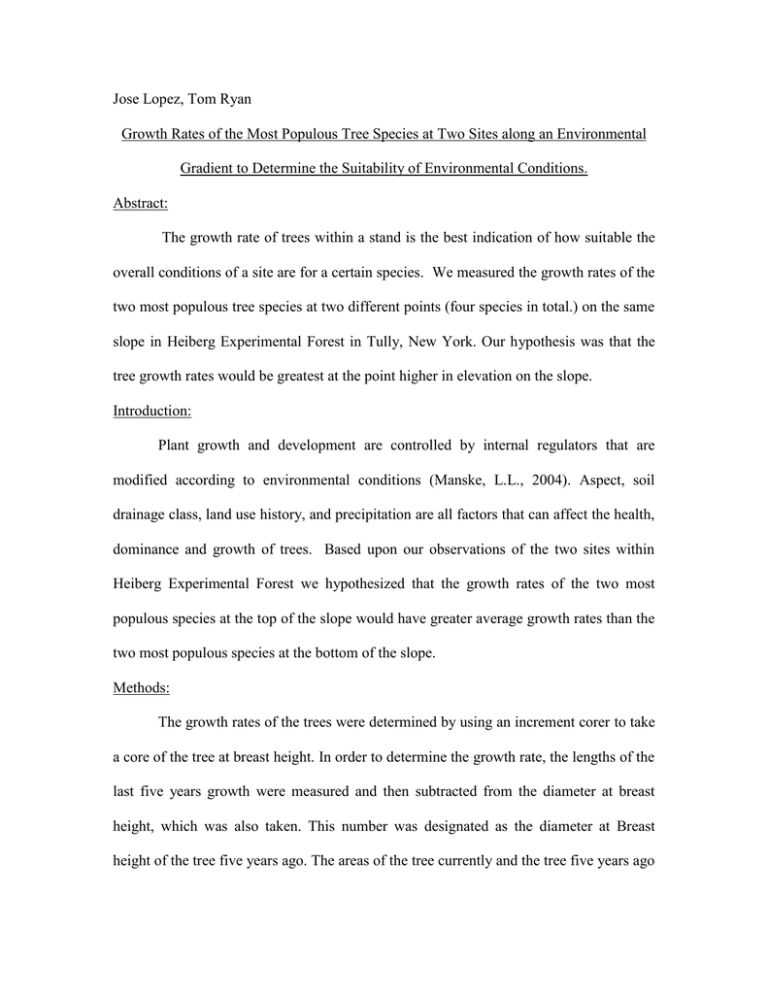
Jose Lopez, Tom Ryan Growth Rates of the Most Populous Tree Species at Two Sites along an Environmental Gradient to Determine the Suitability of Environmental Conditions. Abstract: The growth rate of trees within a stand is the best indication of how suitable the overall conditions of a site are for a certain species. We measured the growth rates of the two most populous tree species at two different points (four species in total.) on the same slope in Heiberg Experimental Forest in Tully, New York. Our hypothesis was that the tree growth rates would be greatest at the point higher in elevation on the slope. Introduction: Plant growth and development are controlled by internal regulators that are modified according to environmental conditions (Manske, L.L., 2004). Aspect, soil drainage class, land use history, and precipitation are all factors that can affect the health, dominance and growth of trees. Based upon our observations of the two sites within Heiberg Experimental Forest we hypothesized that the growth rates of the two most populous species at the top of the slope would have greater average growth rates than the two most populous species at the bottom of the slope. Methods: The growth rates of the trees were determined by using an increment corer to take a core of the tree at breast height. In order to determine the growth rate, the lengths of the last five years growth were measured and then subtracted from the diameter at breast height, which was also taken. This number was designated as the diameter at Breast height of the tree five years ago. The areas of the tree currently and the tree five years ago were derived from this data. The previous area was then subtracted from the current area to find the exact measure of growth that has taken place in the last five years. Once this has been found the average of the 4 trees of each species was taken and those were compared. Results: As hypothesized, our findings illustrate that the growth conditions at plot 1 are on average better than those at plot 7 for the species present there; this is based upon the measurement of average yearly growth rate by difference in basal area mentioned above. (See figure 1) The comparison of red maple at plot 7 against the two sampled species at plot 1 is the main source of our conclusion since the three species grow at roughly the same rate under the same or similar conditions (Walters and Yawney, 1990). Eastern Hemlock is a slow growing, adaptable, shade-tolerant species of conifer that was found in great abundance at site 7. Growth Rate (ft square) Yearly Growth Rate by Species R2 = 0.9783 0.02 0.018 0.016 0.014 0.012 0.01 0.008 0.006 0.004 0.002 0 Sugar Maple Black Cherry Red Maple Plot 1 Eastern Hemlock Plot 7 Species Discussion: The lack of consistency in species between plots one and seven seemed as if it may have skewed the data. The fact that there is such a difference of species composition between the two sites demonstrates how drastically different the two sites are. Since there are so many Eastern Hemlocks but there were no Sugar Maple in the immediate area of site 7 proves the lack of what would traditionally be considered conditions supportive of many hardwoods. This difference in growth conditions and species composition is primarily due to poor soil drainage at site 7. In contrast, the species composition and growth rates of site 1 demonstrate the soil compatibility with many species, which encourages the most competitive species to grow and eventually dominate as sugar maple and black cherry have at site 1. Although Red Maple is a fast growing hardwood, it is not usually competitively successful against other similarly fast growing hardwoods. The reason that red maple is not more present at other sites along the slope is because although it can grow quickly and healthily under those conditions it would be pushed out and dominated by the species such as those of site one, sugar maple and black cherry (Walters and Yawney, 1990). From the results of this experiment, we concluded that one of the greatest limiting factors of the rate of growth at the second site was the soil drainage class. Even so, further experiments with a greater number of subjects and species will provide a much clearer result on if soil drainage conditions and composition are the major limiting factor. Also it might show how other factors like sunlight have major roles in affecting the difference in the rate of growth of the two different sites. To expound upon our results we would recommend a sunlight test be taken and that the results of such a test be compared with the rate of growth and soil test to give a more clear understanding of the local ecosystem and its limitations. Conclusion: Although the measurements taken of basal area do not seem as drastically different as we first expected (Team Gray Van, 2005), but we believe this is because of the closely spaced nature of the trees at the site 7, as well as the fact that many of the trees used to derive that basal area were primarily Eastern Hemlock. These results could prove useful in future management planning because they show the conditions at the two different sites and their greatest limiting agents. This then could be used when selecting the best species to plant at each site or which site has the best conditions to create a specific plantation. This experiment could also be expounded upon to increase the understanding of forest composition and rate of growth in different places, with similarly contrasting conditions along an environmental gradient. References: Manske L. L., environmental factors that affect range plant growth 1892-2003. North Dakota State University, Dickinson research extension center. 2004 annual report. Dickinson, ND Walters, R.S., H.W. Yawney “Acer rubrum L. Red Maple,” from Silvics of North America: Volume 2: Hardwoods. U.S. Department of Agriculture, Forest Service, Washington, DC. “Team Gray Van” lab report, 2005 SUNY ESF, Syracuse, NY.



